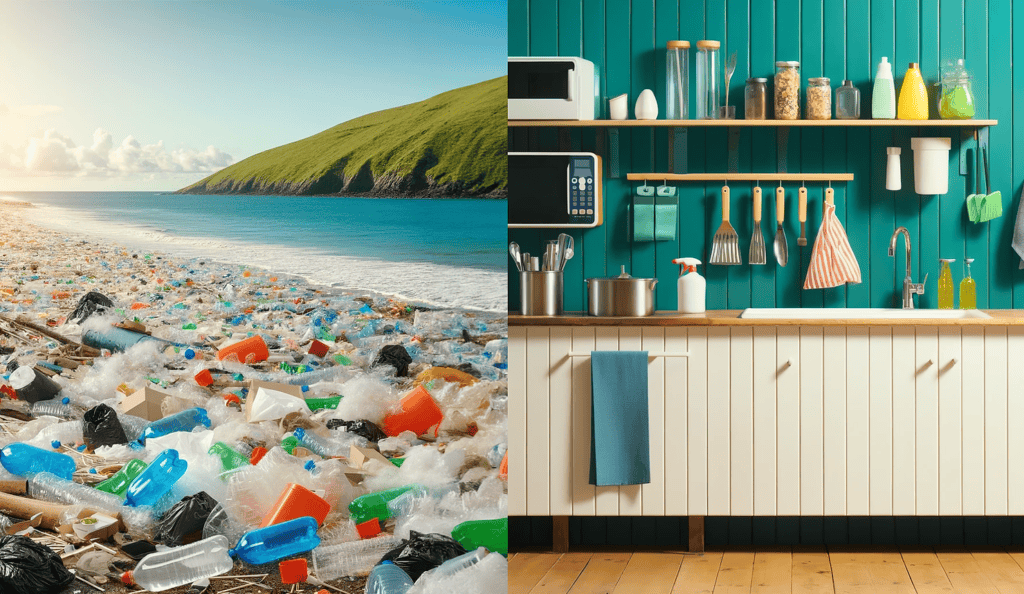Uncover the hidden environmental and health costs of single-use plastics and household cleaners. Learn how Saponetti refill products offer a non-toxic, sustainable solution.
As we hustle through our daily lives, convenience often trumps consideration. Most people still use plastic water bottles when they go to the gym or use plastic bags for convenience. We spritz our countertops with chemical cleaners and toss our groceries into plastic bags without a second thought. But have you ever paused to consider the true cost of these everyday choices? Beyond the few dollars spent, there are significant hidden costs—costs paid by our environment and our health.
- Environmental Impact of Single-Use Plastics
- Hidden Dangers of Household Cleaners
- The Solution? Making Conscious Choices
Environmental Impact of Single-Use Plastics
Mountains of Waste
Globally, we produce about 300 million tonnes of plastic waste each year. Shockingly, half of this is single-use plastic. Items like plastic bottles, straws, and bags are used for mere minutes but take hundreds of years to decompose. This creates a mounting problem: our landfills are overflowing, and our oceans are turning into plastic soup. By 2050, it’s estimated there will be more plastic in the ocean than fish. Think about that next time you sip your drink through a plastic straw.
Wildlife Endangerment
Marine life, from the smallest plankton to the largest whales, is affected by plastic pollution. Animals mistake plastic for food, leading to ingestion and often death. Sea turtles, for instance, cannot distinguish between jellyfish and floating plastic bags. Additionally, plastic debris can entangle animals, causing injury or drowning. The ripple effect is staggering, disrupting entire ecosystems and threatening biodiversity.
Microplastics in Our Water
As plastics break down, they form microplastics—tiny particles less than five millimeters in diameter. These microplastics have infiltrated every corner of our planet, from the depths of the ocean to the peaks of mountains. They even show up in our drinking water. Studies have found microplastics in bottled water, tap water, and even beer!

Hidden Dangers of Household Cleaners
Toxic Ingredients
A significant number of conventional cleaners contain harmful chemicals like ammonia, chlorine, and phthalates. These substances can cause a range of health issues, from skin irritations to respiratory problems. Volatile Organic Compounds (VOCs) in cleaners can lead to chronic respiratory issues and contribute to indoor air pollution, which is often worse than outdoor air pollution. Think about that next time you breathe in the “fresh” scent of your favorite cleaner.
Environmental Pollution
When we rinse cleaners down the drain, they don’t just disappear. Many of these chemicals are not effectively removed by wastewater treatment plants and end up in our rivers, lakes, and oceans. This contamination can harm aquatic life and disrupt ecosystems. Moreover, packaging for these products often involves single-use plastics, adding to the mounting waste problem.
Hormone Disruption
Some chemicals in household cleaners, such as triclosan and certain phthalates, are known endocrine disruptors. These substances can interfere with our hormone systems, potentially leading to reproductive issues, developmental problems in children, and an increased risk of certain cancers.
Saponetti: A Sustainable Solution
Saponetti refill products are a game-changer in the fight against single-use plastics and harmful chemicals. These non-toxic, eco-friendly products are designed to protect both your health and the environment. By choosing Saponetti, you can significantly reduce your plastic waste and avoid exposure to dangerous chemicals. Their refill system promotes reuse, ensuring that convenience doesn’t come at a high environmental cost.

The Solution? Making Conscious Choices
Reduce and Reuse
Opt for reusable items whenever possible. Invest in a sturdy water bottle, carry reusable shopping bags, and choose products with minimal packaging. By reducing our reliance on single-use plastics, we can collectively decrease demand and waste.
Go Natural
Switch to natural, eco-friendly cleaning products. Many household cleaners can be replaced with simple ingredients like vinegar, baking soda, and essential oils. These alternatives are not only safer for your health but also kinder to the environment.
Educate and Advocate
Awareness is the first step towards change. Share information with friends and family about the hidden costs of plastics and chemical cleaners. Support policies and companies that prioritize sustainability. Every voice counts in the fight for a cleaner, healthier planet. Check out and follow Environmental Defence and the Toronto Environmental Alliance (TEA) to learn about how you can get involved.
Conclusion
The hidden costs of single-use plastics and household cleaners are significant and far-reaching. While the convenience of these products is undeniable, the environmental and health impacts are too substantial to ignore.
By making mindful choices, we can reduce our footprint and contribute to a more sustainable world. Let’s choose wisely, for ourselves, for our planet, and for future generations.
With every small step, we move closer to a world where convenience doesn’t come at such a high cost. Let’s make our convenience count for good.
FAQs
What are some easy swaps for single-use plastics?
Use reusable water bottles, shopping bags, and food containers. Opt for glass or metal straws instead of plastic ones.
Are natural cleaners as effective as conventional ones?
Yes, natural cleaners like vinegar, baking soda, and essential oils can be very effective for most household cleaning tasks.
How can I get involved in advocating for reduced plastic use?
Support policies that reduce plastic production and waste, participate in local clean-up events, and educate others about the importance of reducing plastic use.

